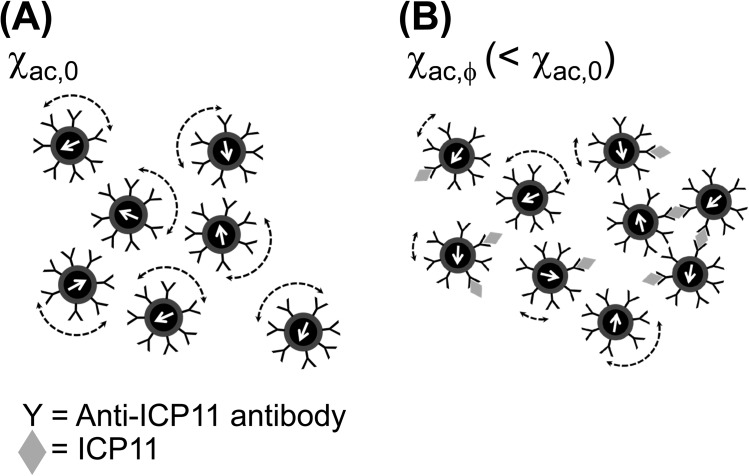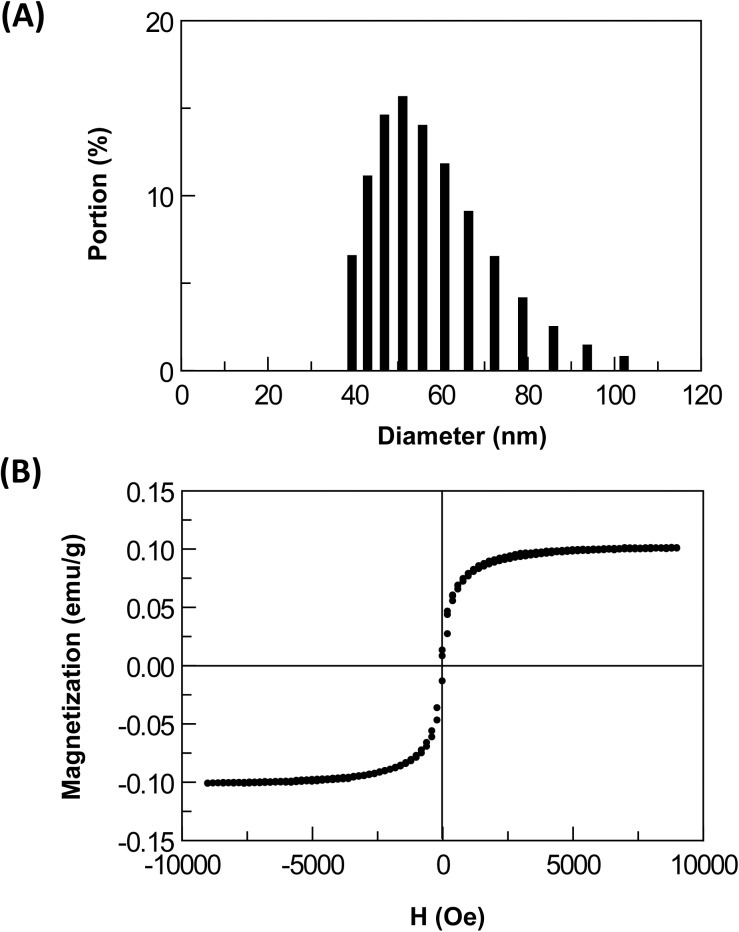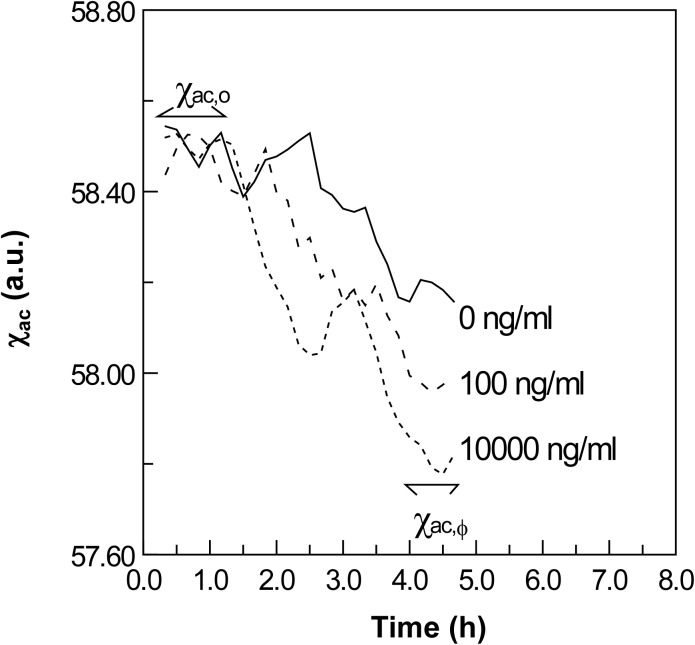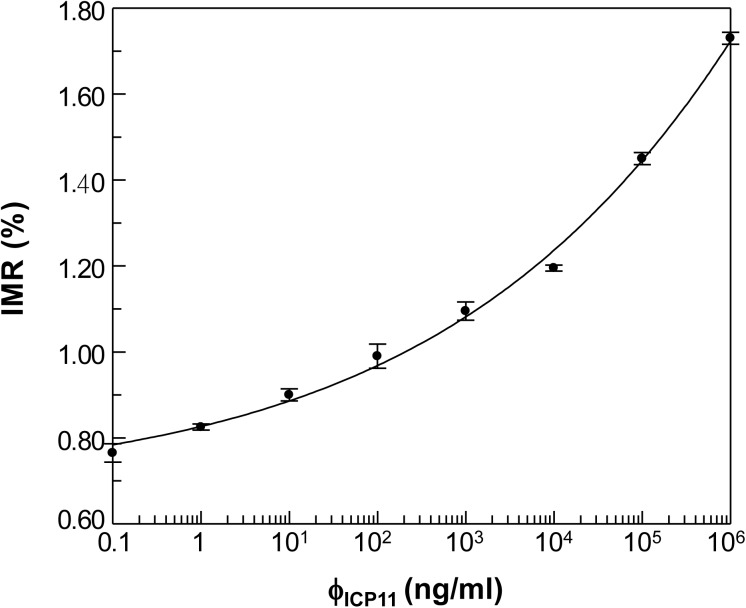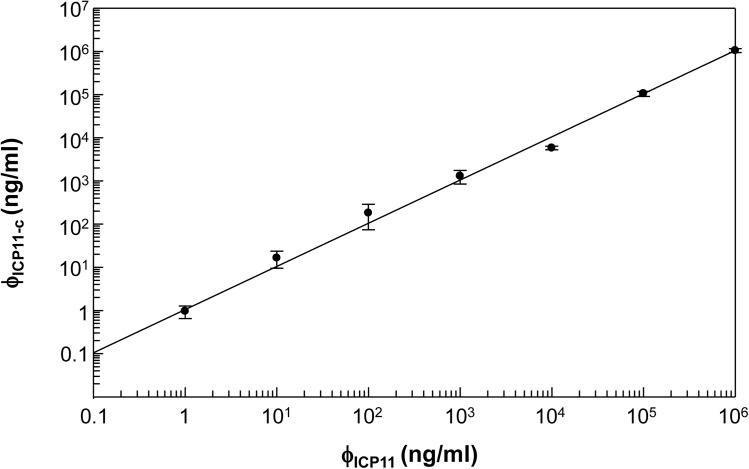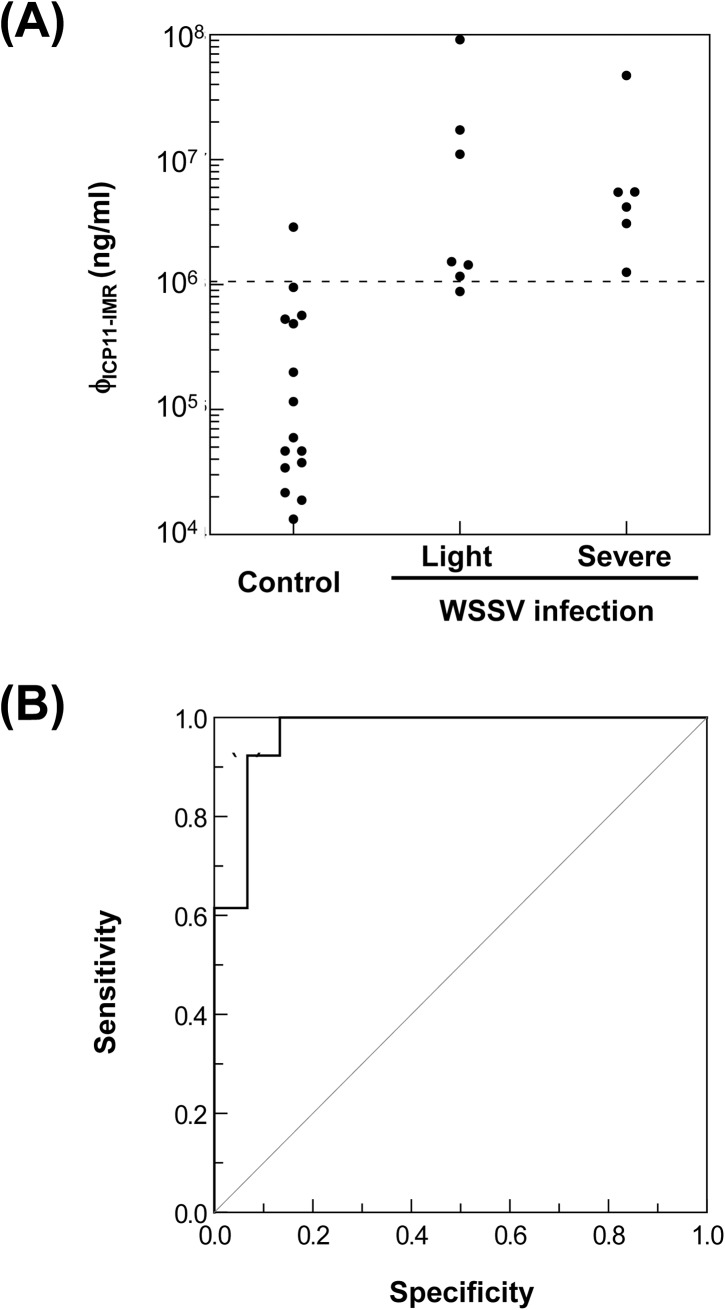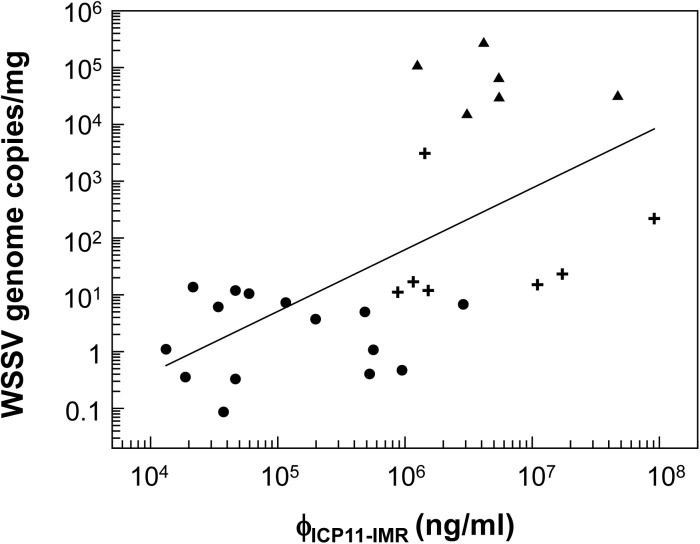Abstract
Shrimp white spot disease (WSD), which is caused by white spot syndrome virus (WSSV), is one of the world’s most serious shrimp diseases. Our objective in this study was to use an immunomagnetic reduction (IMR) assay to develop a highly sensitive, automatic WSSV detection platform targeted against ICP11 (the most highly expressed WSSV protein). After characterizing the magnetic reagents (Fe3O4 magnetic nanoparticles coated with anti ICP11), the detection limit for ICP11 protein using IMR was approximately 2 x 10−3 ng/ml, and the linear dynamic range of the assay was 0.1~1 x 106 ng/ml. In assays of ICP11 protein in pleopod protein lysates from healthy and WSSV-infected shrimp, IMR signals were successfully detected from shrimp with low WSSV genome copy numbers. We concluded that this IMR assay targeting ICP11 has potential for detecting the WSSV.
Introduction
White spot disease (WSD), which is caused by white spot syndrome virus (WSSV), is a globally important shrimp disease [1, 2]. Over the past 20 y, WSD has caused huge economic losses to shrimp aquaculture around the world. All life stages of penaeid shrimps, i.e. from egg to brooder, are potentially susceptible to WSSV. In shrimp hatcheries, the virus can be transmitted vertically from WSSV-positive brooder to offspring [3]. Furthermore, cannibalization of WSSV-infected, moribund shrimp is primarily responsible for horizontal transmission [4]. Therefore, effective diagnostic methods and appropriate biosecurity and management are critical to prevent the spread of WSD.
There are several systems for detecting WSSV. A high sensitivity, polymerase chain reaction (PCR) based system for WSSV is now commercially available and popular in large-scale shrimp farms [5–9]. However, the relatively high cost of this assay, plus the need for specialized equipment and technical expertise, limits its use in small-scale operations. Therefore, an immune-based detection system has appeal as an alternative, due to its lower cost and technical requirements [10]. For example, home pregnancy tests are a widely used, immune-based detection system [11]. Immune-based WSSV diagnostic systems using gold-labeled antibodies or other platforms have been developed [10, 12–15]. The sensitivity of the assay depends on the target protein. Current immune-based WSSV diagnostic systems target WSSV structural proteins, which assemble to form WSSV virion particles [16].
Before “omic” approaches were developed, specific WSSV structural proteins, e.g. VP28, VP24, VP19 and VP15, were thought to be the most highly expressed genes/proteins. Consequently, these WSSV structural proteins were the targets detected in immune-based WSSV diagnostic systems [16]. However, using transcriptomics and proteomics, Wang et al. [17] reported that ICP11 was the most highly expressed WSSV gene/protein. This nonstructural protein is expressed in the late stage of WSSV replication and functions as a DNA mimic protein which interferes with nucleosome structure and causes cell death [17, 18]. In addition to being expressed at a high level (compared to VP28), ICP11 is very soluble and can be easily detected in WSSV-infected tissue lysate using methods that are inexpensive and technically simple [17]. Siriwattanarat et al [19] subsequently developed a monoclonal antibody against ICP11 that had stronger immunoreactivity than other monoclonal antibodies specific for VP28 and VP19, indicating that this could improve detection sensitivity for WSSV. Therefore, we inferred that ICP11 was both a good indicator of WSSV infection and a suitable candidate for an immune-based diagnostic system for this pathogen.
Instead of current immune-based diagnostic systems that involve antibodies against epitopes of target protein, the immunomagnetic reduction (IMR) assay we use here provides an ultra-high sensitivity immune-based detection with a single antibody. In an IMP assay, a specific antibody that recognizes the target protein is immobilized on magnetic nanoparticles, and thus enables them to specifically bind to the target protein. Magnetic nanoparticles in reagents oscillate with alternating current (AC) magnetic fields via magnetic interaction. Therefore, under the influence of external AC magnetic fields, the original reagent containing homogeneously dispersed magnetic nanoparticles generates a magnetic signal, called multiple-frequency ac magnetic susceptibility χac,0 (Fig 1A). After target proteins are bound to antibody-labeled magnetic nanoparticles, the resulting magnetic susceptibility is designated χac,ϕ (Fig 1B). Due to the formation of magnetic clusters, χac,ϕ is smaller than χac,0.. Thus, the reduction in χac of the magnetic reagent is used to determine the concentration of the target protein. Due to cost efficiency, quantification and ease of automatization, the IMR platform is becoming increasingly important as a diagnostic approach. In addition to its use in human diseases [20–23], an IMR assay was also used to detect Nervous Necrosis Virus (NNV), a major viral pathogen for grouper and other fish [24–25].
Fig 1. Overview of immunomagnetic reduction (IMR).
(A) Each magnetic nanoparticle, bio-functionalized with antibodies against target proteins, oscillates with the applied alternating current (AC) magnetic field before binding with ICP11. χac,0: the original multiple-frequency AC magnetic susceptibility of the magnetic nanoparticles (B) When these magnetic nanoparticles bind to target proteins, they become larger, and some even form clusters. This reduces the AC magnetic susceptibility of the reagent. χac,ϕ: the resulting magnetic susceptibility of magnetic nanoparticles after binding with the target proteins.
The objective here was to develop a sensitive IMR-based diagnostic system for WSSV that targeted the ICP11 protein. First, an anti-WSSV ICP11 antibody was conjugated onto Fe3O4 magnetic nanoparticles; thereafter, particle diameter, time-dependent AC magnetic susceptibility and concentration-dependent IMR signals were determined. Second the, detection efficiency of the WSSV ICP11 IMR assay was determined by comparing the ICP11-IMR signals in lysates extracted from shrimp pleopods to the WSSV virion copy numbers (assessed with real-time PCR).
Materials and Methods
Virus, virus inoculum and experimental shrimp
The virus used was a WSSV Taiwan isolate (GenBank accession no. AF440570), with the WSSV stock prepared as described [26]. The experimental inoculum was diluted from this stock with PBS (137 mM NaCl, 2.7 mM KCl, 10 mM Na2HPO4, and 2 mM KH2PO4).
Shrimp (Litopenaeus vannamei; ~10 g body weight) were purchased from a commercial market. After acclimation for 1~2 d in water tank systems containing sterilized seawater (30 ppt at 25~27°C), shrimp were divided into two groups: a PBS-injected group (control) and an infected group. Control shrimp were injected with PBS, whereas infected shrimp were challenged with WSSV inoculum (2.2 WSSV copies/μl; 100 μl/shrimp) by intramuscular injection. At 24-h post injection, pleopod samples from both groups were collected and subjected to IMR and real-time PCR.
Determination of WSSV genome copy number in shrimp pleopod samples
To determine the infection level in WSSV-infected shrimp, we used the IQ REALTM WSSV Quantitative System (GeneReach Biotechnology Corp., Taiwan), which is an absolute quantitative method that measures the amount of viral genomic DNA. Pleopod samples were collected as described previously [27] and total genomic DNA (shrimp and viral) extracted with a DTAB/CTAB DNA extraction kit (GeneReach Biotechnology Corp., Taiwan). A real-time qPCR reaction was performed on a CFX ConnectTM Real-Time PCR machine (BioRad) following the IQ REALTM WSSV Quantitative System manufacturer’s instructions. The Dual P (+) Standard provided by the kit contains 106 copies/μl of fragments of both WSSV and shrimp genomic DNA. This standard was series-diluted to generate a standard curve (106, 105, 104, 103, 102, and 101 copies/μl) which was used to determine virion copy numbers.
Expression and purification of recombinant ICP11
The full-length ICP11 gene was cloned into a pET 21b expression vector (Novagen). Recombinant ICP11 protein fused with a C-terminal His6-tag was expressed in E. coli BL21 (DE3) cells at 20°C and purified as described previously [17, 18]. The resulting recombinant ICP11 protein was verified by SDS-PAGE.
Extraction of protein lysate from shrimp samples for Western blot analysis
To extract the protein lysates for Western blot analysis, the pleopods from healthy and WSSV-infected shrimp were homogenized in lysis-PBS buffer (PBS diluted 3x in ddH2O at 4°C) with protein inhibitor and centrifuged at 10,000 xg for 15 min. The concentrations of the total protein lysates in the supernatant were then quantified using a Bio-Rad Bradford protein assay (Bio-Rad). After mixing with SDS-sample buffer (1% SDS, 15% glycerol, 10 mM Tris-HCl [pH 6.8], 10% beta-mercaptoethanol), samples (20 μg) were separated on 15% SDS-PAGE. After separation, samples were either stained with Coomassie Brilliant Blue, or else transferred onto a polyvinylidene difluoride (PVDF) membrane, incubated with anti-ICP11 antibody or anti-VP28 antibody, and then detected with a horseradish peroxidase (HRP)-conjugated secondary antibody. Detected proteins were visualized using an ECL detection system (Perkin-Elmer).
Extraction of protein lysate from shrimp pleopod samples for the immunomagnetic reduction (IMR) assay
Total shrimp pleopod samples (15 mg per group) were homogenized in 200 μl lysis-PBS buffer at 4°C, kept on ice for 5 min, and then centrifuged (10,000 xg for 10 min) with the supernatants being collected in 1.5 ml microcentrifuge tubes. Total protein concentrations were measured with a Qubit® 2.0 fluorometer (Invitrogen), and the protein lysates were stored at -20°C until the IMR assay was performed.
Detailed illustrations for IMR have been published [22, 28]. The reagent contained homogeneously dispersed Fe3O4 magnetic nanoparticles (MF-DEX-0060, MagQu, Taiwan), which were coated with hydrophilic surfactants and a polyclonal anti-ICP11 antibody [17].
The antibody was covalently bound onto the magnetic nanoparticles as described previously [24, 29] or by using a commercial kit (KT-COO-0060, MagQu, Taiwan). The size distribution of the Fe3O4 magnetic nanoparticles coated with anti ICP11 was analyzed with dynamic laser scattering (Nanotrac 150, Microtrac). For testing, 40 μl of magnetic reagents (Fe3O4 magnetic nanoparticles coated with anti ICP11) was mixed with 60 μl total protein lysate (diluted 200x) and an immunomagnetic analyzer (XacPro-E, MagQu, Taiwan) was used to assess the IMR signals. The percent reduction in the χac of the reagent was defined as the IMR signal, IMR (%), and was calculated as follows:
| [Formula 1] |
Results and Discussion
Expression of WSSV ICP11 and VP28 in WSSV-infected shrimp
As shown in Fig 2, a protein band of approximately 11 kDa was recognized by the anti-ICP11 polyclonal antibody only in the protein lysates from the pleopods of WSSV-infected shrimp. By contrast, Western blotting with the WSSV VP28 antibody detected a relatively faint 28 kDa band. No non-specific signals were detected by either antibody, suggesting that the anti-ICP11 antibody and anti-VP28 antibody both had a specificity against their respective targets. After this experimental demonstration of the high specificity of the anti-ICP11 antibody, we considered this polyclonal antibody against ICP11 to be suitable for the subsequent IMR assays. These results also show that, compared to VP28, the lysates contained a relatively large amount of WSSV ICP11, which should make it a good target for an immune-based detection system.
Fig 2. Western blot analysis of WSSV ICP11 and VP28 in total lysates from shrimp pleopods (PL) collected from healthy (PBS) and WSSV-infected shrimp.
After separation and transfer to PVDF membrane, samples were probed with (A) anti-ICP11 antibody or (B) anti-VP28 antibody. (C) To show the protein loading, the SDS-PAGE was stained with coomassie blue. M: Prestained Protein Ladder (10–170 kDa)
Characteristic of the ICP11 IMR
Magnetic nanoparticles were 55.4 ± 12.3 nm (mean ± SD; Fig 3A), with a saturated magnetization of 0.1 electromagnetic unit (emu)/g (Fig 3B).
Fig 3. The magnetic reagent used in this study.
(A) Distribution of the diameter of anti-ICP11 coated Fe3O4 nanoparticles. (B) Magnetic hysteresis curve of reagent containing anti-ICP11 coated Fe3O4 nanoparticles.
To determine the immune reactivity of the magnetic reagent containing the Fe3O4 magnetic nanoparticles coated with anti ICP11, the reagent was mixed with varying concentrations of recombinant ICP11 protein (0−104 ng/ml) and IMR was used to determine the time-dependent ac magnetic susceptibility. The continuous real-time magnetic response, χac, for the various concentration of ICP11 is shown in Fig 4. The signal from the magnetic reagent with 0 ng/ml ICP11 was used as a negative control. After 1.5 h, the χac started to decrease and mostly continued to decrease through to the termination of measurement at 4.5 h.
Fig 4. Time-dependent AC magnetic susceptibility of reagent reacting with rICP11 protein in PBS solution with various concentrations of ICP11.
At 4.5 h, although there was a reduction in the χac signal in the negative control, the reduction was clearly greater in the samples with 100 or 10,000 ng/ml rICP11. Based on these reductions, we concluded that the magnetic nanoparticles reacted with the ICP11 protein molecules.
IMR signals as a function of rICP11 concentration
To establish the relationship between rICP11 concentration and the percent reduction in χac signals from the magnetic reagent, the IMR (%) signals were plotted against rICP11 concentration (ϕICP11) (Fig 5). As the rICP11 concentration increased from 1 ng/ml to 0.1 x 106 ng/ml, the corresponding IMR signal also increased. A measurement of the reliability of these IMR signals is given by the coefficient of variation (CV), which is defined as the ratio of the standard deviation to the mean value of the detected signals. Usually, no matter how strong/weak the signal is, the CV should be less than 3%, which corresponds to high precision. As shown in S1 Table, all of the CV values were below this threshold, and we therefore conclude that the detected IMR signals shown in Fig 5 are reliable. The relationship between IMR (%) and ϕICP11 can be described as follows:
| [Formula 2] |
in which A, B, ϕo, and γ are fitting parameters.
Fig 5. IMR (%)–ϕICP11 (spiked-rICP11-concentration in PBS) curve showing concentration-dependent IMR signals for ICP11 with standard deviations (duplicate measurements).
Using the data in Fig 5, the outcome was: A = 0.678, B = 9.948, ϕo = 1.04 x 1012, and γ = 0.15. The resulting fitting curve was plotted using a solid curve (Fig 5). The coefficient of determination (R2) between the data points and the curve was 0.996. It is worth noting that A in the logistic function denotes the noise level for the IMR signal (i.e. IMR signal at ϕICP11 = 0). This formula can also be used to calculate the ICP11 concentration of shrimp samples.
Detection limit of the ICP11 IMR platform
The detection limit is defined as the lowest concentration of target protein that produces an IMR signal at least 3 standard deviations greater than the baseline noise level. The standard deviation for IMR at low concentrations (e.g. 0.1 ng/ml ICP11) was 0.02% (See S1 Table). Since the baseline noise signal, A, is 0.678, the limit of detection in terms of the IMR signal is (0.678 + 3 x 0.02) % = 0.738%. Based on Formula 2, this would give an ICP11-IMR detection limit of ~0.002 ng/ml.
Linear dynamic range (LDR) of the quantitative ICP11 IMR
To convert IMR signals into ICP11 concentration (denoted ϕICP11-c), the detected IMR signals (Fig 5) were applied to the logistic function. The relationship between ϕICP11-c and ϕICP11 was plotted in Fig 6. The slope of the ϕICP11-c- ϕICP11 curve was 1.05, and coefficient of determination (R2) was 0.999. The requirement for determining the range of linearity in terms of ICP11 protein concentration is that the slope of the ϕICP11-c- ϕICP11 curve lies between 0.9 to 1.1. Hence, these results demonstrate that the IMR assay for ICP11 protein has a linear dynamic range from 0.1 to 1 x 106 ng/ml.
Fig 6. Linear correlation between actual ICP11 concentration (ϕICP11) and ICP11 concentration (ϕICP11-c) as measured by IMR in Fig 5.
IMR assay to detect ICP11 protein in protein lysates extracted from pleopods of healthy and WSSV-infected shrimp
Pleopods were collected from both the control (PBS-injected) and WSSV-infected groups. One of the pleopods from each shrimp was used to measure the WSSV viral copy number by real-time PCR, while the other pleopod was used for the IMR assay.
Based on the IQ REALTM WSSV Quantitative System (which determines the number of WSSV copies per mg tissue), samples from the WSSV-infected group were categorized into two subgroups: light infection (7 samples; 10 ~ 3100 WSSV copies/ mg tissue) and severe infection (6 samples; 1.57 x 104 ~ 2.83 x 105 WSSV copies/mg tissue). Although control shrimp were not experimentally challenged with WSSV, a low level infection (0.08 ~ 7 WSSV copies/mg tissue) was detected, which we inferred was due to persistent infection.
The IMR assay was used to detect the ICP11 concentrations (ϕICP11-IMR) in a total of 28 samples (Fig 7A). Detected ICP11 concentrations of samples collected from healthy shrimp (albeit with an apparent low-level persistent infection) were mostly < 1 x 106 ng/ml, whereas the ϕICP11-IMR of shrimp with a light or severe infection consistently exceeded 1 x 106 ng/ml. Using receiver operating characteristic (ROC) curve analysis (Fig 7B), the cut-off value of ICP11 concentration between non-challenged shrimp with apparent persistent infection and WSSV-challenged shrimp with light/severe infection was 10.55 x 105 ng/ml with a specificity of 0.933 and sensitivity of 0.923.
Fig 7. IMR detection of ICP11 protein in shrimp.
(A) Measured ICP11 protein concentration (ϕICP11-IMR) in non-challenged shrimp (normal control) and in shrimp with a light or severe WSSV infection. The cut-off value (the dashed line) was based on ROC curve analysis of the IMR results. (B) Sensitivity and specificity of the IMR assay as determined by ROC curve analysis.
Fig 8 plots the detected ICP11 concentrations (ϕICP11-IMR) against the number of WSSV genome copies per mg in shrimp in the control and WSSV-infected groups. We note that although the control shrimp had a low number of WSSV genome copies (< 10 copies / mg tissue; Fig 8) these same shrimp nevertheless had high ϕICP11-IMR values of 104~106 ng/ml. Even though ICP11 is the most highly expressed WSSV protein, it seems unlikely that such a high concentration of the protein would be produced by so few copies of the virus; the ϕICP11-IMR values may therefore not be truly representative of the actual quantity of ICP11 present in the lysates. The reason for this apparent discrepancy is not clear. The Western blots in Fig 2 eliminate the possibility that the polyclonal antibody may be directly cross-reacting with shrimp tissue, but unexpected non-specific cross-reaction with other proteins cannot be ruled out. Distorted ϕICP11-IMR values might also arise if the ICP11 is in polymeric form and/or if it is bound to histone DNA (18) because these large molecules/complexes will cause a correspondingly large reduction in the χac signal. Unfortunately, it may be that the ϕICP11-IMR values calibrated by purified ICP11 cannot be directly applied to ICP11 in shrimp lysate. Clearly, more work will need to be done to investigate this issue.
Fig 8. Correlation between detected ICP11-IMR concentration and WSSV copy number.
Pleopod samples were collected from shrimp and subjected to IMR assay and real-time PCR. Dots indicate shrimp belonging to the non-challenged control group (0.08 ~ 7 WSSV copies/mg tissue); crosses indicate light infection (10 ~ 3100 WSSV copies/mg tissue); triangles indicate severe infection (1.57 x 104 ~ 2.83 x 105 WSSV copies/mg tissue).
Conclusions
In this study, we developed an immunomagnetic reduction (IMR) assay to detect ICP11 (a highly expressed WSSV protein) in shrimp. To our knowledge, this protein has never been used as the target in an immune-based WSSV diagnostic system. A simple process was used to extract ICP11 protein from shrimp pleopods, and the protein was subsequently quantified using a high-sensitivity IMR assay. Despite some unexpectedly high ϕICP11-IMR values in some of the putatively healthy shrimp, we nevertheless conclude that this ICP11-based IMR assay has great potential for the early detection of WSSV in shrimp.
Supporting Information
(DOCX)
Data Availability
All relevant data are within the paper and its Supporting Information files.
Funding Statement
This work was supported by Agricultural Technology Research Institute in Taiwan (grant 103AG-a5.2-08). The funders had no role in study design, data collection and analysis, decision to publish, or preparation of the manuscript. BHL, YCL, CSH, CCY, YTC, JFC, YFL, MHH, FCL and SYY are employed by MagQu Co. The funder provided support in the form of salaries for authors [BHL, YCL, CSH, CCY, JFC, YFL, MHH, FCL and SYY], but did not have any additional role in the study design, data collection and analysis, decision to publish, or preparation of the manuscript. The specific roles of these authors are articulated in the 'author contributions' section.
References
- 1. Escobedo-Bonilla CM, Alday-Sanz V, Wille M, Sorgeloos P, Pensaert MB, Nauwynck HJ. A review on the morphology, molecular characterization, morphogenesis and pathogenesis of white spot syndrome virus. J Fish Dis. 2008; 31:1–18 [DOI] [PubMed] [Google Scholar]
- 2. Pradeep B, Rai P, Mohan SA, Shekhar MS, Karunasagar I. Biology, host Range, pathogenesis and diagnosis of White spot syndrome virus. Indian J Virol. 2012;23:161–174 10.1007/s13337-012-0079-y [DOI] [PMC free article] [PubMed] [Google Scholar]
- 3. Lo CF, Ho CH, Chen CH, Liu KF, Chiu YL, Yeh PY, et al. Detection and tissue tropism of white spot syndrome baculovirus (WSBV) in captured brooders of Penaeus monodon with a special emphasis on reproductive organs. Dis Aqua Org. 1997;30:53–72 [Google Scholar]
- 4. Lo CF, Kou GH. Virus-associated white spot syndrome of shrimp in Taiwan: A review. Fish pathology. 1998;33:365–371 [Google Scholar]
- 5. Lo CF, Leu JH, Ho CH, Chen CH, Peng SE, Chen YT, et al. Detection of baculovirus associated with white spot syndrome (WSBV) in penaeid shrimps using polymerase chain reaction. Dis Aqua Org. 1996;25:133–114 [Google Scholar]
- 6. Nunan LM, Lightner DV. Optimized PCR assay for detection of white spot syndrome virus (WSSV). J Virol Methods. 2011;171:318–321 10.1016/j.jviromet.2010.11.015 [DOI] [PubMed] [Google Scholar]
- 7. Mendoza-Cano F, Sánchez-Paz A. Development and validation of a quantitative real-time polymerase chain assay for universal detection of the White Spot Syndrome Virus in marine crustaceans. Virol J. 213;10:186 [DOI] [PMC free article] [PubMed] [Google Scholar]
- 8. Leal CA, Carvalho AF, Leite RC, Figueiredo HC. Development of duplex real-time PCR for the detection of WSSV and PstDV1 in cultivated shrimp. BMC Vet Res. 2014;10:150 10.1186/1746-6148-10-150 [DOI] [PMC free article] [PubMed] [Google Scholar]
- 9. Tsai YL, Wang HC, Lo CF, Tang-Nelson K, Lightner D, Ou BR, et al. Validation of a commercial insulated isothermal PCR-based POCKIT test for rapid and easy detection of white spot syndrome virus infection in Litopenaeus vannamei . PLoS One. 2014;9:e90545 10.1371/journal.pone.0090545 [DOI] [PMC free article] [PubMed] [Google Scholar]
- 10. Powell JWB, Burge EJ, Browdy CL, Shepard E. Efficiency and sensitivity determination of Shrimple ®, an immunochromatographic assay for white spot syndrome virus (WSSV), using quantitative realtime PCR. Aquaculture. 2006;257:167 [Google Scholar]
- 11. Gnoth C, Johnson S. Strips of hope: Accuracy of home pregnancy tests and new developments. Geburtshilfe Frauenheilkd. 2014;74: 661–669 [DOI] [PMC free article] [PubMed] [Google Scholar]
- 12. Poulos BT, Pantoja CR, Bradley-Dunlop D, Aguilar J, Lightner DV. Development and application of monoclonal antibodies for the detection of white spot syndrome virus of penaeid shrimp. Dis Aquat Organ. 2001;47:13–23 [DOI] [PubMed] [Google Scholar]
- 13. Liu W, Wang YT, Tian DS, Yin ZC, Kwang J. Detection of white spot syndrome virus (WSSV) of shrimp by means of monoclonal antibodies (MAbs) specific to an envelope protein (28 kDa). Dis Aquat Organ. 2002;49:11–18 [DOI] [PubMed] [Google Scholar]
- 14. Chaivisuthangkura P, Longyant S, Rukpratanporn S, Srisuk C, Sridulyakul P, Sithigorngul P. Enhanced white spot syndrome virus (WSSV) detection sensitivity using monoclonal antibody specific to heterologously expressed VP19 envelope protein. Aquaculture. 2010;299:15–20 [Google Scholar]
- 15. Sithigorngul P, Rukpratanporn S, Chaivisuthangkura P, Sridulyakul P, Longyant S. Simultaneous and rapid detection of white spot syndrome virus and yellow head virus infection in shrimp with a dual immunochromatographic strip test. J Virol Methods. 2011;173:85–91 10.1016/j.jviromet.2011.01.011 [DOI] [PubMed] [Google Scholar]
- 16. Chaivisuthangkura P, Longyant S, Sithigorngul P. Immunological-based assays for specific detection of shrimp viruses. World J Virol. 2014; 3:1–10 10.5501/wjv.v3.i1.1 [DOI] [PMC free article] [PubMed] [Google Scholar]
- 17. Wang HC, Wang HC, Kou GH, Lo CF, Huang WP. Identification of icp11, the most highly expressed gene of shrimp white spot syndrome virus (WSSV). Dis Aquat Organ. 2007;74:179–189 [DOI] [PubMed] [Google Scholar]
- 18. Wang HC, Wang HC, Ko TP, Lee YM, Leu JH, Ho CH, et al. White spot syndrome virus protein ICP11: A histone-binding DNA mimic that disrupts nucleosome assembly. Proc Natl Acad Sci U S A. 2008;105:20758–20763 10.1073/pnas.0811233106 [DOI] [PMC free article] [PubMed] [Google Scholar]
- 19. Siriwattanarat R1, Longyant S, Chaivisuthangkura P, Wangman P, Vaniksampanna A, Sithigorngul P. Improvement of immunodetection of white spot syndrome virus using a monoclonal antibody specific for heterologously expressed icp11. Arch Virol. 2012;158:967–979 10.1007/s00705-012-1569-3 [DOI] [PubMed] [Google Scholar]
- 20. Yang CC, Yang SY, Chieh JJ, Horng HE, Hong CY, Yang HC, et al. Biofunctionalized magnetic nanoparticles for specifically detecting biomarkers of Alzheimer's disease in vitro . ACS Chem Neurosci. 2011;2:500–505 10.1021/cn200028j [DOI] [PMC free article] [PubMed] [Google Scholar]
- 21. Chang CH, Lai ZX, Lin HL, Yang CC, Chen HH Yang SY, et al. Use of immunomagnetic reduction for C-reactive protein assay in clinical samples. Int J Nanomedicine. 2012;7:4335–4340 10.2147/IJN.S31030 [DOI] [PMC free article] [PubMed] [Google Scholar]
- 22. Yang CC, Yang SY, Ho CS, Chang JF, Liu BH, Huang KW. Development of antibody functionalized magnetic nanoparticles for the immunoassay of carcinoembryonic antigen: a feasibility study for clinical use. J Nanobiotechnology. 2012;12:44 [DOI] [PMC free article] [PubMed] [Google Scholar]
- 23. Yang CC, Yang SY, Chen HH, Weng WL, Horng HE, Chieh JJ, et al. Effect of molecule-particle binding on the reduction in the mixed-frequency ac magnetic susceptibility of magnetic bio-reagents. J Appl Phys. 2012;112: 24704 [Google Scholar]
- 24. Lu MW, Yang SY, Horng HE, Yang CC, Chieh JJ, Hong YW, et al. Immunomagnetic reduction assay for nervous necrosis virus extracted from groupers. J Virol Methods. 2012;181: 68–72 10.1016/j.jviromet.2012.01.012 [DOI] [PubMed] [Google Scholar]
- 25. Yang SY, Wu JL, Tso CH, Ngou FH, Chou HY, Nan FH, et al. A novel quantitative immunomagnetic reduction assay for Nervous necrosis virus. J Vet Diagn Invest. 2012;24:911–917 10.1177/1040638712455796 [DOI] [PubMed] [Google Scholar]
- 26. Su MA, Huang YT, Chen IT, Lee DY, Hsieh YC, Li CY, et al. An invertebrate Warburg Effect: a shrimp virus achieves successful replication by altering the host metabolome via the PI3K-Akt-mTOR pathway. PLoS Pathog. 2014;10: e1004196 10.1371/journal.ppat.1004196 [DOI] [PMC free article] [PubMed] [Google Scholar]
- 27. Chen IT, Aoki T, Huang YT, Hirono I, Chen TC, Huang JY, et al. White spot syndrome virus induces metabolic changes resembling the Warburg effect in shrimp hemocytes in the early stage of infection. J Virol. 2011; 85:12919–12928 10.1128/JVI.05385-11 [DOI] [PMC free article] [PubMed] [Google Scholar]
- 28. Hong CY, Wu CC, Chiu YC, Yang SY, Horng HE, Yang HC. Magnetic susceptibility reduction method for magnetically labeled immunoassay. Appl Phys Lett. 2006;88: 212512 [Google Scholar]
- 29. Yang SY, Jian ZF, Horng HE, Hong CH, Yang HC, Wu CC, et al. Dual immobilization and magnetic manipulation of magnetic nanoparticles. J Magn Magn Mater. 2008;320: 2688–2691 [Google Scholar]
Associated Data
This section collects any data citations, data availability statements, or supplementary materials included in this article.
Supplementary Materials
(DOCX)
Data Availability Statement
All relevant data are within the paper and its Supporting Information files.



